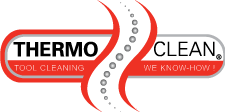A wide range of after-treatment techniques
After thermal or chemical paint stripping, in a lot of cases it is advisable to perform an after-treatment. This after-treatment sees us remove the residual dust, paint residue or a thin coat of chemical product. Depending on the type of part and the expected end result, we commit one of our after-treatment techniques.
Both thermal and chemical paint stripping leave a residue on the cleaned part. In the case of thermal cleaning, this is dust, including pigments, inorganic fillers and ashes. After chemical paint stripping, there is often some paint residue or a thin coat of chemical product.
After-treatment is a necessity
In order to ensure the intended finished product quality is achieved, a purpose-adapted after-treatment is necessary. This desired finished product quality is specified by way of a Thermo-Clean quality code.
We sit down with the customer ahead of time to discuss the desired code, along with the right processing flow of the parts.
This quality code is programmed into our production software at the start of the assignment. For each part to be cleaned – depending on the type of material and the intended finished product quality – we compile the processing programme from start to finish. This programme tells everybody exactly what needs to be done when, and exactly what the customer’s requirements are.
What are the after-treatment techniques on offer?
High-pressure cleaning
The most straightforward after-treatment technique is to thoroughly hose down the parts with a high-pressure cleaner. The swiftness and the finished product quality of this cleaning treatment depends on the use of hot or cold water, the flow rate and the water pressure.
Blasting
After thermal cleaning, we treat the parts with sandblast jets. This ensures a higher degree of quality compared against a high-pressure cleaner. Blasting is applied to hooks, brackets, grilles, and rejected parts. We offer a variety of blasting media: grit blasting, steel shot, corundum, glass bead blasting wet/dry and carbon dioxide pellets.
Pickling
To remove residual flash rust and dust particles, we treat these parts with a pickling process. Pickling is advisable for customers that have high quality requirements. Compared to blasting, pickling has the benefit that it does not cause the surface to become roughened, which means any hinging parts continue to work properly. During pickling, we use a phosphoric acid solution and a few inhibitors to remove the residual material. Any rust is removed by way of a dipping.
The full bath series is made up of a pickling bath, a few rinse baths and a passivation bath. The latter puts a water-based coat on the cleaned parts which means they are protected against rust for a few days. Between the various bath treatments, the parts are jetted with a high-pressure cleaner to remove any loose dirt particles. Once the parts have gone through the full treatment, they are dried down and ready for inspection and packing.
Glass bead blasting
We offer dry as well as wet glass bead blasting:
- Dry glass bead blasting
This extremely fine after-treatment method uses tiny glass beads, which are blasted onto the part to be cleaned inside a manual blasting cabinet. The blasting medium is so fine that it barely roughens the surface in a way that is visible to the eye. Thanks to the adjustable pressure, this technique also enables us to properly clean finer parts. - Wet glass bead blasting
This technique sees us use tiny glass beads that are projected onto the part to be cleaned with water and some compressed air. The water reduces the abrasiveness of the glass beads to practically zero. This after-treatment only removes the dust residue, and leaves the substrate untouched. The perfected after-treatment for metallic parts, such as extruder screws, die plates, … Both treatments guarantee that your parts can be immediately reused in your production process.
Carbon dioxide
Frozen ice pellets (-78 °C) are blasted onto the surface to be cleaned in the form of carbon dioxide, using adapted equipment under compressed air of 7 to 9 bar. Because of the impact energy, the carbon dioxide pellets transform back into carbon dioxide gas, causing their volume to amplify around 650 times. The combination of this ‘explosion’, the extreme cooling and the hammering effect of the ice particles on the surface acts to dislodge the contamination from the substrate without damaging the latter. This allows us to perfectly clean more delicate surfaces.
Ultrasonic
After-treatment with ultrasonic sound waves is made to occur inside a bath filled with a specific liquid. Through this liquid we emit sound waves. These sound waves go on to form tiny bells in the liquid. These bells implode against the surface of the parts to be cleaned, thereby removing the contamination.
We adopt this method for delicate materials or materials with very tiny holes where residual dirt can amass.
Vibration drum
Small parts such as closing plugs, small hooks and rods, etc. require an appropriate after-treatment. For such parts, we use vibration: a vibrating rotating drum lined with small sharp ceramic stones, a mixture of water and a passivation product. The vibration of the rotating drum causes the small wet stones to grate along the contaminated parts, which wipes them clean. After approximately fifteen minutes, the cleaned parts are transferred to a dry rotating drum. A few minutes later, they come out ready to be packed. The decision which ceramic particles to use depends on the parts to be cleaned.
